Three years ago, none of us would have imagined that we would be living through a worldwide pandemic for two years and counting. More than 5 million people dead worldwide. Healthcare disparities are more exposed than ever. Masking. Waiting in line for testing and vaccinations. Friends and family separated by closed borders. A new disease that spread through the world by travelers. For those of us that love to travel, it is a challenge to think about ethical tourism in the time of the COVID pandemic.
In this period where travel has been impossible or at least difficult, we have been musing about the role of travel in our lives. Is ethical tourism a privilege? A right? Necessity? Disease vector? Irresponsible? Sustainable?
We just took our first international flight and first trip on an airplane since February 2020. Our last trip was to Singapore and now, our first trip is back to Singapore. That’s where one of us (Reggie) is from and where we have many friends and family. We are staying here for three months.
Table of Contents
Being In Singapore During The Emergence Of COVID
We were here in January and February 2020 during the emergence of COVID. It was clear right from the start that something world-changing was beginning. When we left Singapore, everyone was wearing masks, there were temperature checks at malls, MRT subway stations, and the airport, the government was already doing extensive contact tracing, and people were greatly concerned about COVID.
Wuhan was already on lockdown, and it was frightening to see an entire region walled off. But it was already too late. Seven million residents of Wuhan had left in January. More than 10,000 were in Singapore. Even more in Thailand and Europe and the US. It was clear that border closing would never contain the virus. Before we left Singapore, we wrote a Facebook post that concluded, “it’s only a matter of time before coronavirus is an epidemic in more than one country.”
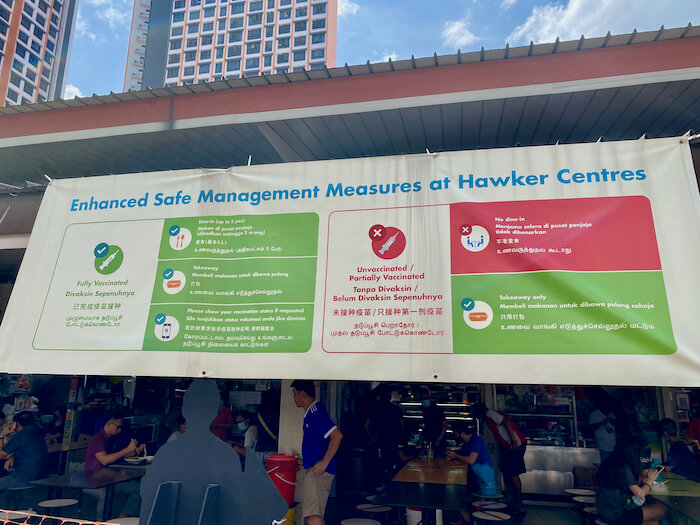
Access to the Hawker Center in Singapore is much more controlled than before COVID. Only vaccinated people are allowed to dine in, the number of people in a group is restricted and everyone has to use the TraceTogether app to sign in and out.
The US—Unprepared For The Onslaught
As we boarded the plane to return to the US in February 2020, the only question we were asked during checking in for the flight was: “Have you been in China in the past two weeks?” By then, COVID had already traveled worldwide. Brought by people. Travelers. Business travelers. Holiday travelers. Family reuniting travelers. The same is true for every mutation that has happened since then. Eighteen hours later, we walked off the plane into a country totally unprepared for the onslaught of COVID.
Actually, there was one person that was concerned about COVID. When we called Sue’s then 90-year-old mother to tell her we were on the way back to the US, she told us that we weren’t to visit her for two weeks. How she knew about COVID and the two-week quarantine, we’ll never know.
The Onslaught March 2020
The onslaught came in March 2020 with a fury. By the end of the month, there would be 100,000 cases diagnosed in the US and stay-at-home orders for non-essential workers issued in 26 states. By early April, dozens of people had died in nursing homes and assisted living facilities in Seattle—the sign of many more deaths to come.
Two years later, we are now in yet another wave of COVID—the Omicron mutation. Recently re-opened borders are closing again as the new variant explodes around the world. At the same time, some countries are removing restrictions because the virus is so widespread that infected travelers don’t make a difference. There is talk of living with endemic COVID.
Why Travel?
Reggie and I love to travel. For us, travel is developmental. It helps us to grow and see/experience the world in new ways. We grow from interacting with new (to us) people and cultures, learning our shared collective history, seeing the amazing creations of us humans, and marveling at the wonders of the natural world. The pyramids of Giza. Machu Pichu. Angkor Wat. Antarctica. Easter Island. Serengeti. The Galapagos Islands. Petra. We are in awe of all that mankind has created and the differences and similarities in our cultures and histories. We’ve been saddened as we examine and try to understand what Sue’s mother called “man’s inhumanity to man—the Killing Fields in Cambodia, the Museum of the Disappeared in Chile, concentration camps in Europe, Robben Island in South Africa, the Underground Railroad Museum in the US among other places.
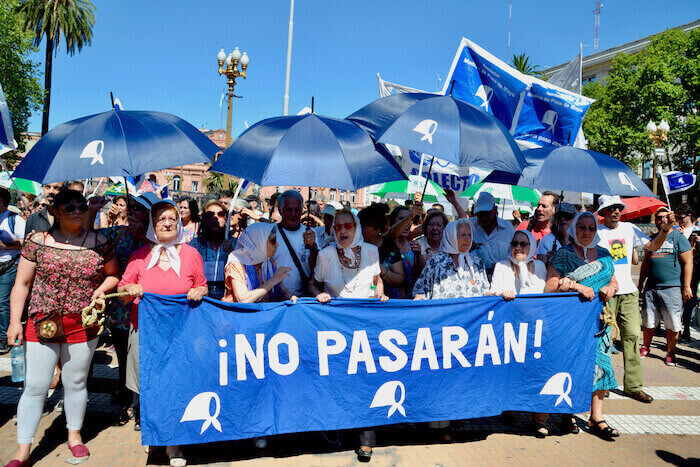
Las Madres de la Plaza De Mayo in Buenos Aires. The grandmothers have been protesting the disappearance of their children and grandchildren since 1977. More than 30,000 people were murdered during the brutal regime.
Before COVID, we (many of us) in the world lived as if we were disconnected. Separate entities with separate problems. Occasionally, those of us in the richer countries would have a glimpse (ourselves included) of how the “other half lived,” and then go home to our countries, secure that the problems in Africa or Asia or South America or the Middle East would stay within those borders. We are aware this is a somewhat unfair generalization, but it is, nonetheless, largely the case.
Then came COVID.
And this illusion was shattered. The virus was worldwide before we even knew it.
Over the past two years, there have been some powerful expressions of our shared humanity. We have gotten sick and recovered and died and grieved and prayed and lived and created together.
We have also failed together.
The developing, richer countries hoard vaccines and treatments while Africa, South America, and Asia die and mutations develop. Then new COVID mutations travel back to the US, Europe, and the entire planet. More people suffer and borders close again. But the borders don’t close to COVID–only to people (and commodities).
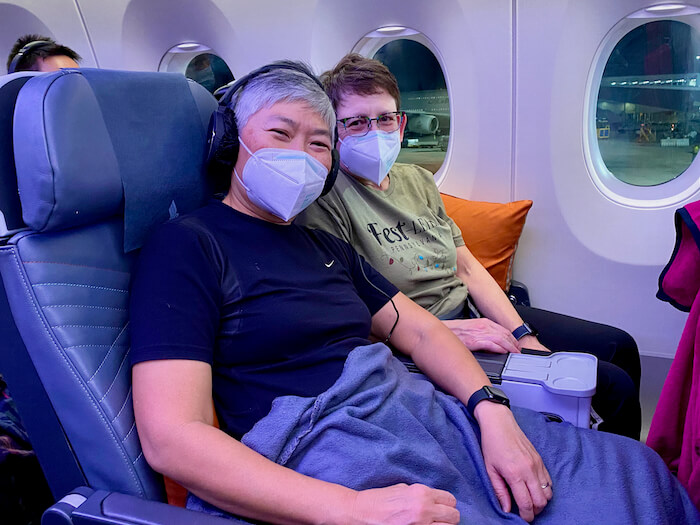
The authors on the way to Singapore, December 2021. Our first trip on a plane since February 2020.
So, What Of Travel and Ethical Tourism?
Over the past two years, we explored locally—walkabouts in New York City (the Yiddish word is shpatzir—to wander aimlessly). Snowshoeing in the parks in New Jersey. Visiting every outdoor sculpture park in New York and New Jersey. Eating and drinking outdoors in the winter. Photographing the stunning solitude and emptiness of Broadway, the shutdown theater district in New York City. Documenting street art from the Black Lives Matters protests.
The vaccines arrived, cases went down, borders began to tentatively reopen, and travel internationally became a possibility. Then came Delate. Then came Omicron. Then came …
What does it mean to travel now? Travel is part of the flow of COVID. Border closings are part of the story of COVID.
We Are Going to Singapore
We were privileged to be able to travel to Singapore in December and to successfully navigate the many requirements which included pre-departure testing, applying for permission to enter, booking a Vaccinated Travel Lane (VTL) flight, uploading documents, doing a COVID test each day for seven days after we arrived, and downloading an application onto our phones that tracks everywhere that we go. Yet, we are both happy to be in Singapore and delighted to see friends and family that we haven’t seen for two years.
It’s not our usual trip where we visit many other countries while we are in Southeast Asia. In 2020, we went to Australia and Borneo (Malaysia) while we were here. The previous year it was Vietnam, Cambodia, and Malaysia. This time, we plan to stay put because of the possibility of being locked out if the borders close with short notice. And the possibility of getting sick or bringing COVID with us to another location.
We know some people that have traveled extensively during COVID even before the vaccines were available. They enjoyed having many places all to themselves. And we know people that hopped on a plane as soon as they were vaccinated. We weren’t ready to take the risk to travel until we could go to the place that was the most important for us personally. Even then, we had second thoughts. Now that we are here, we are delighted.
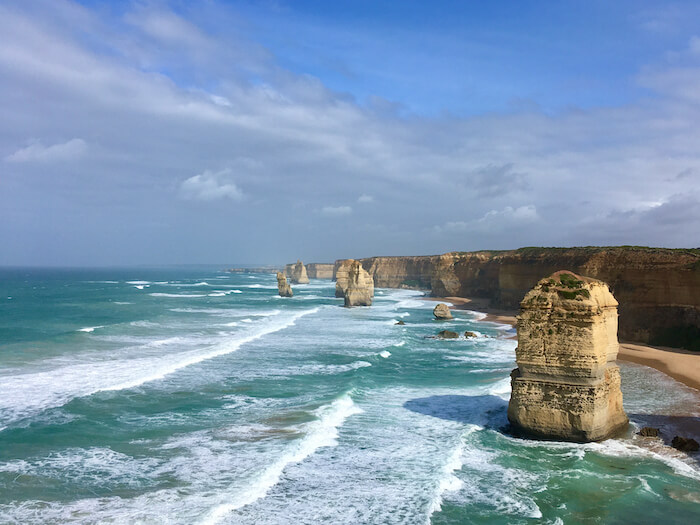
Ethical Tourism means skipping well-known sites like the Great Ocean Road in Australia and finding new and less traveled places.
10 Ideas For Ethical Tourism
So, back to our earlier question. What of travel? How do we travel honestly, authentically, and safely in this new era we are in? In some places, there are fights about masking, vaccine mandates, “bodily freedom,” and much more. For us, it’s about how we express our caring for the world as we travel. In our opinion travel is important—not just for fun and relaxation—but for enabling people to experience each other’s lives and histories.
1. Community-Centric Travel
We need to make thoughtful decisions about destinations and how we enter the communities. Putting the community first before own agendas, wants, and desires is a moral activity. Just like choosing to dress appropriately in a religiously conservative country, wearing a mask, quarantining, and testing is a sign of caring and respect. This also includes voluntarily quarantining before leaving for a destination to minimize the possibility of bringing along COVID or any other illness. This was our practice even before COVID as one of us has hearing problems and can’t fly if she has even the slightest hint of a cold.
2. Slow Down And Then Slow Down More
When we went to Melbourne, we spent eight days in the city—a relatively short time. We were constantly asked—why are you spending so much time there? Why not go to Sydney too? In eight days, we were just getting to know the city. Slow travel means taking time to experience local life.
As we planned our trip to Singapore, we discussed the reality that we weren’t going to be able to visit any other countries. This trip is about reconnecting with friends and family, learning about their experiences of the past two years. Singapore has had 800+ deaths from COVID. The US has had 800,000. Despite these major differences, many of our experiences are shared—we laugh about the shortages of hand sanitizers, and masks, and toilet paper, commiserate about border closings, and not being able to see people for two years. And feel sad about the people that are no longer with us.
Being here for three months also means that we get to go to the Botanic Gardens as many times as we like and eat at our favorite hawker stalls as many times as we want.
3. Practice Patience, Flexibility, And Preparedness
Even though we were on a VTL flight, we had to plan for what would happen we were sent to a quarantine facility if either one of us tested positive when we landed. Since Singapore doesn’t recognize gay marriage, we were prepared for being separated. That changed how we packed and planned. We always plan for the most likely scenarios and how to prepare for them. COVID has added a few new possibilities.
4. Carefully Meet All Entry Requirements
Entry requirements are a part of travel and have been acerbated by COVID. They change frequently. The Singapore COVID entry requirements were very specific and could not be done last minute. Reggie researched them and made sure we followed them exactly. We always plan for our trips, but COVID adds new wrinkles now and for the future.
5. Travel Local
We didn’t take any trips out of the country or more than a car ride away for two years. At the same time, we traveled extensively. What do we mean by that? There are endless places to explore and adventures to create where we live. Discovering new things right in your own backyard is not just fun, it is an important way to support local, small, and family-owned businesses, particularly those not in a “tourist area.”
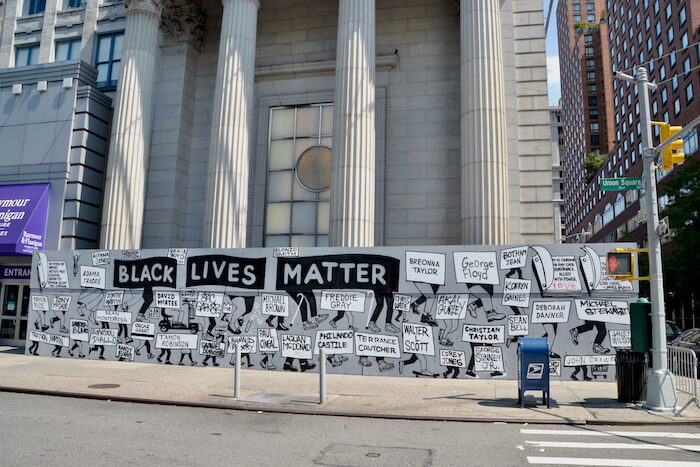
Black Lives Matter mural in Union Square, New York City
6. Commit To Anti-Racist and Anti-Colonialism Travel
By committing to anti-racist and anti-colonial travel, we’re not talking about attending protests while you travel (though we have done that). What we do mean is to bring an understanding of anti-racism and anti-colonialism to our travel and our stories about our travels. Visiting places related to slave trading, colonial history, and genocide (indigenous people, people of color, Jewish) is a meaningful way to learn the history and life of a country. Remember that you are walking in other people’s pain and destruction. When we go to one of these places, we allow time for processing and experiencing the history and the pain. Time for understanding our historical and present days roles. Photos, social media, and blog posts need to be written with this in mind.
7. Travel Somewhere Where You Are Not The Dominant Group
Travel gives the opportunity to experience/feel race, religion, nationality, and ethnicity in a new way. This is especially true if you stay and spend time in local neighborhoods, outside of the tourist areas. It is, unfortunately, the case that Caucasians are the dominant race throughout the world and you can’t just take off your class and race privileges. You can, however, try to see the world with new eyes, with a non-dominant perspective. Doing this well takes practice and a self-conscious sensibility. Otherwise, you run the risk of being an exploitative dilettante.
8. Lighten Up on Photoshop
The context of photos matters. So often, perfect, beautiful photos are posted on blogs and social media—photoshopped photos that don’t convey the reality of the place. This is especially true of street art posts. We love street art and public art. Most of what is posted on social media doesn’t convey the reality and the neighborhood in which the art lives. The art isn’t being created in a vacuum. Let’s be real about where we are—give your viewers the real deal, not the fantasy.
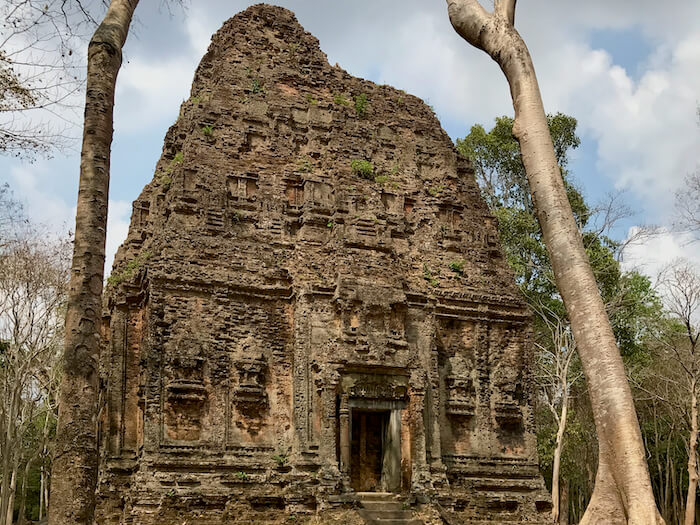
Instead of the crowded and overtouristed Angkor Wat, consider visiting Sambor Prie Kuk in Cambodia or another one of the many temples in the country.
9. Explore The Places Less Traveled
Over tourism is a major issue. Everyone wants to see the Eiffel Tower, Machu Pichu, Venice, Angkor Wat, and the Grand Canyon. We hate crowds so if we go to popular spots, we go off-season. Better yet, we explore somewhere new—not on the tourist reel. It can be much more rewarding to explore the places that are forgotten. And, it is good for the local economy.
So, where have we landed (besides Singapore) on ethical tourism? We’ll keep traveling when it is safe and developmental for us and for the people were are visiting and meeting. And, keep working on how to do this in the best and most caring way, following the ideas that we have outlined above.
10. Visit A Nonprofit And Provide Monetary Support
We often visit a local school, NGO, or other community-based organizations when we travel. In Tibet, we went to a school for the visually impaired. In Mexico, a microenterprise organization. In Cuba, we brought medical supplies. In addition, we always make a monetary contribution to the NGO. Some people like to do volunteer activities when they travel. You’ll need to be careful when doing that that you are helping, not burdening the NGO.
This post is not exhaustive–there are many more issues to think about relative to sustainable and ethical tourism, carbon offsetting, community-centered travel, voluntourism, and more. Travel is a privilege and we need to keep that perspective as we find new ways to do it as our world evolves.
We hope that we have given you some food for thought. We’d love to hear your thoughts about these ideas for the future of travel. How are you thinking about your own travel? Responsible travel? When and where are you going on your first or next trip?
Please Pin and Share
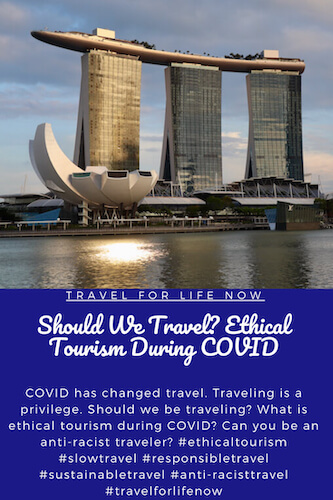
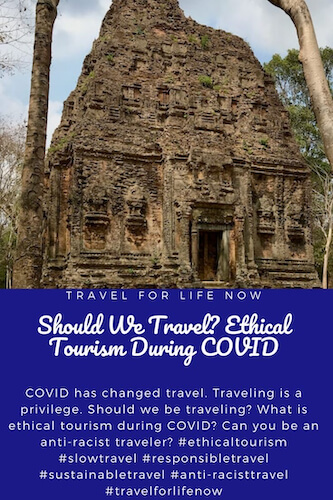
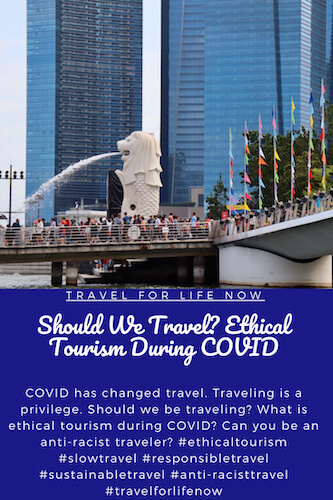

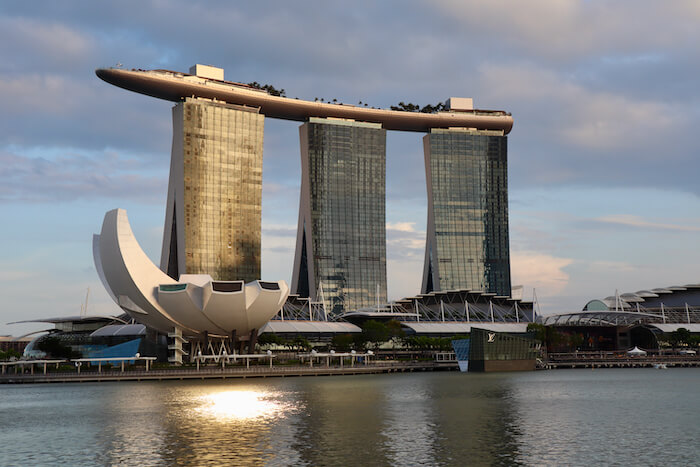
You are so right! I think after COVID, it became even more important for me to visit local places, rather than the tourist areas. I’d rather support the locals and even have a more local experience.
Amy,
Thanks for reading and commenting. Local and immersive travel is very rewarding. Where are you exploring?
Sue